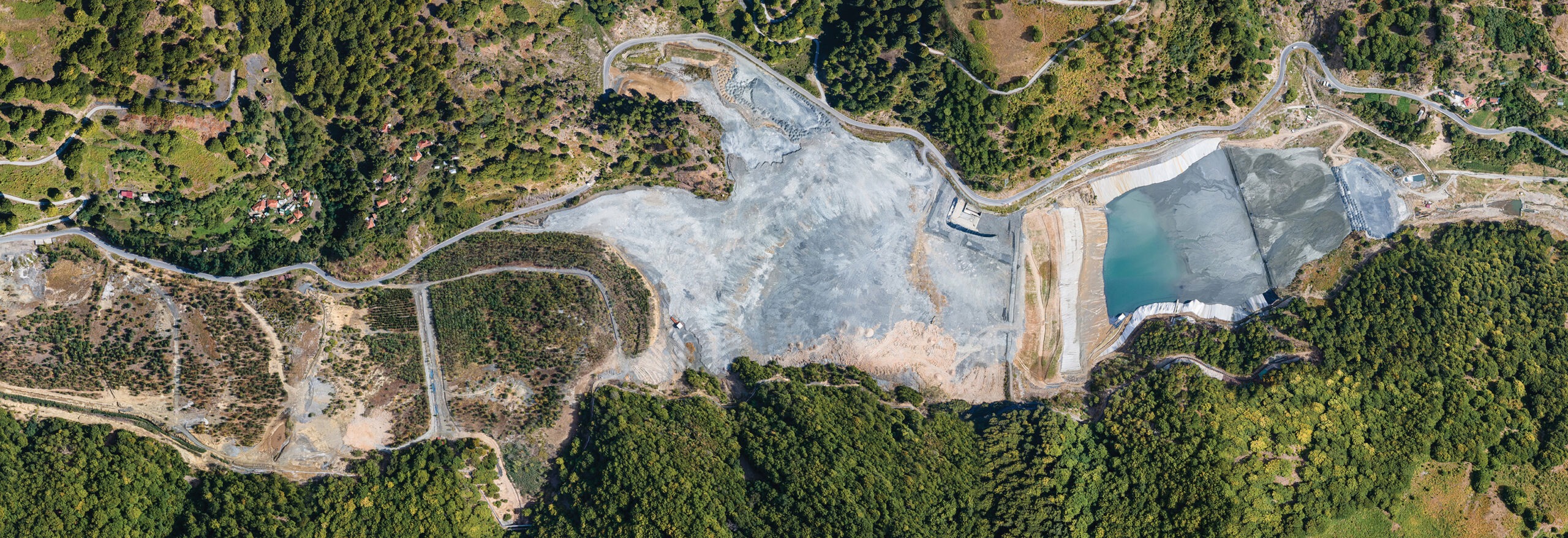TAILINGS MANAGEMENT
Sasa is firmly committed to the long-term environmental and socially responsible disposal of tailings.
Our approach
The Sasa Tailings Storage Facility (‘TSF’) comprises five tailings dams, which have been constructed using the downstream construction method.
All of Sasa’s tailings dams are designed to take into account the specific environmental setting in which they are located, which includes but is not limited to, grain size, slope angle and height of dam wall above the pond.
At Sasa we aim to minimise associated impacts with regards to waste management. This is why we have committed to transitioning to paste fill mining at Sasa, which will allow disposal of tailings in cemented paste backfill underground to minimise the quantity of tailings stored on the surface. In addition, we are adopting the Dry Stack Tailings (‘DST’) method for a significant portion of the remaining tailings.
DST will allow for a larger volume of material to be stored in a smaller footprint. This method, combined with the paste fill mining, will provide storage capacity for 70% of Sasa’s Life of Mine (‘LoM’) tailings to 2039, with the remaining 30% to be stored in the existing TSF4.
GLOBAL INDUSTRY STANDARD ON TAILINGS MANAGEMENT
The Global Industry Standard on Tailings Management (‘GISTM’) is based on 15 core principles spread across six topics, ranging from potentially affected communities, through design and construction, to facilities management and planned emergency response.
Adoption of GISTM is not a legal requirement, though is required of members of the International Council on Mining & Metals (‘ICMM’), an industry body comprising 24 of the world’s largest mining companies.
CAML decided to adopt GISTM on a voluntary basis to demonstrate its commitment to safe and sustainable mining practices.
OUR CONFORMANCE WITH THE GISTM
CAML’s GISTM conformance has been independently audited by international consultants Knight Piésold (‘KP’). According to KP:
“For the Sasa TSFs, all GISTM requirements have either been met (92%), or are met with a plan in place (8%), and therefore CAML conforms with GISTM.
“Excellent progress has been made since KP’s first audit in 2020, including commissioning of the paste backfill plant, design of the DST, improvement of the day-to-day management of the facilities and the appointment of roles defined under GISTM.
“Sasa’s TSFs are well managed and operated by an experienced team that follow GISTM requirements for tailings governance. “A significant milestone is the commissioning of the DST due to occur in H2 2024.
“Adopting filtered tailings stacks is an example of best available technology and is in line with international best practice.”
See our GISTM public disclosures document for more information.
TSF 1
Status: Closed
In operation: 1964-1974
Height: 44m
Current TSF storage volume: 1.4 Mm3
Planned 5-year TSF: storage volume: As above
TSF 2
Status: Closed
In operation: 1974 – 1990
Height: 62m
Current TSF storage volume: 4.8 Mm3
Planned 5-year TSF: storage volume: As above
TSF 3.1
Status: Closed
In operation: 1990-2003 / 2006-2007
Height: 61m
Current TSF storage volume: 4.9 Mm3
Planned 5-year TSF: storage volume: As above
TSF 3.2
Status: In closure phase
In operation: 2007- 2020
Height: 67m
Current TSF storage volume: 5.3 Mm3
Planned 5-year TSF: storage volume: As above
TSF 4
Status: Active
In operation: 2020 –
Height: 66m (final height based on Project Design)
Current TSF storage volume: 1.0Mm3 as of 06.2022
Planned 5-year TSF: storage volume: 1.8

Tailings Facilities have the potential to be one of the most significant safety and environmental risks for the mining industry. CAML are committed to minimising this risk by ensuring our facilities are designed, constructed, operated, and maintained in accordance with industry best practice and standards.
As part of CAML’s governance management strategy for the tailings dams at Sasa, the following processes are in place, which align with GISTM:
Accountable Executive – CAML has appointed its CEO as the Accountable Executive is accountable for the safety of tailings facilities and avoiding or minimising the social and environmental consequences of a tailings facility failure.
Responsible Person – At Sasa we have appointed a Responsible Tailings Facility Engineer (‘RTFE’), to ensure ownership and appropriate management of the tailings facility. The RTFE consults with the Engineer of Record (‘EOR’), the Accountable Executive as well as the internal site teams such as operations, regulatory affairs, social performance and environment. The RTFE is an appropriately qualified and experienced individual who is based full-time at the operation.
Engineer of Record – Sasa has appointed an independent and appropriately qualified, experienced, and licensed EOR. The EOR has responsible charge over the design of the facility and provides ongoing support during operations and through the lifespan of the facility.
Inspections – The tailings facilities at Sasa are regularly inspected by our appropriately qualified operational staff daily. Additionally, an external Independent Tailings Engineer is responsible for monitoring, reviewing and reporting on Sasa’s TSFs on a monthly basis. The Independent Tailings Engineer produces a monthly report and presents the report findings to Sasa’s management and TSF Stability Committee. Key aspects reviewed include:
levels in the piezometers in the dam wall
TSF drainage flow rates and water quality
survey levels
grain size analysis from the cyclones
height of the dam wall relative to pond levels etc
dam slope angle relative to design
TSF Stability Committee – the Committee meets on a monthly basis and is attended by members of the TSF operational team, EOR, RTFE, Independent Tailings Engineer, Sasa Technical Director, Sasa Environment Manager and chaired by the Sasa General Director. The Committee remit is to review monitoring data from the Independent Tailings Engineer and other key aspects of TSF management including compliance with GISTM
Independent Audits – Independent audits of the facilities are undertaken annually to assess whether the design, construction and operation of the facilities meets international best practice standards. The Audit will also provide recommendations to reduce risks associated with the TSFs going forward. The results of the audit and the implementation progress of any recommendations are conveyed to the Board of Directors via our quarterly Sustainability Committee meetings.
Review and Monitoring of Sasa's Tailing Storage Facilities
Sasa’s tailings dams have been constructed in line with North Macedonian standards. The monitoring data generated from monitoring of the tailings facilities is regularly reviewed by an external Independent Tailings Engineer for the University of Goce Delcev, Stip. This information is also shared with the regulator.
In 2016, Golder Associates (global tailings dam experts) undertook an audit and review of the facilities at Sasa and, in February 2019, CAML instructed that group to perform a third-party stability review of TSF3.2.
In September 2020, global consultancy, Knight Piésold, was retained to undertake a full independent review of TSF4 following the leakage.
During July 2021, Knight Piésold undertook an independent tailings facility audit at Sasa to assess whether the design, construction and operation of the facilities met international best practice standards and to provide recommendations to reduce risks associated with the TSFs going forward. Subsequent audits will be undertaken on an annual basis.
During H2 2022, Sasa will complete the installation of an automated monitoring and surveillance system which will include but not be limited to piezometers, water quality sensors and other technologies to monitor the tailings facilities. Pre-determined trigger levels for surveillance activities are in place at Sasa, when a trigger level is breached, trigger action response plans (‘TARP’) are in place.
Sasa has created a monitoring system called Cyclops that allows site teams to monitor the TSFs and other parameters in real time, and from anywhere in the world.
Pre-determined trigger levels for surveillance activities are in place, and when a trigger level is breached, trigger action response plans (‘TARP’) are in place.
